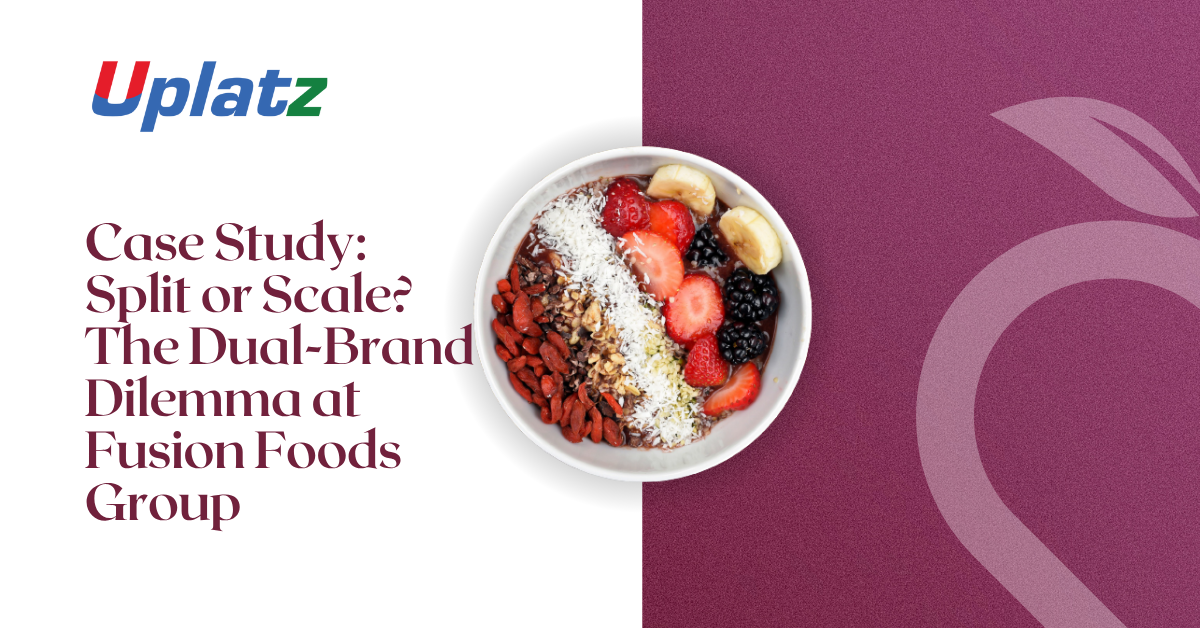📘 Case Study: “Split or Scale? The Dual-Brand Dilemma at Fusion Foods Group”
Company Background
Fusion Foods Group (FFG) is a London-based multinational food and beverage conglomerate founded in 2005. It owns and operates a diverse portfolio of food brands across Europe, North America, and parts of Asia. The group’s two crown jewels are:
- PureHarvest: A premium organic, sustainable food brand offering cold-pressed juices, plant-based meals, and gluten-free snacks. It is positioned at the top end of the health-conscious market, selling in boutique retailers and high-end grocery chains across the UK, France, and Germany.
- Snackify: A fun, affordable snack brand focused on indulgent chips, candies, and convenience snacks for the mass market. It is a volume-driven brand distributed through supermarkets, petrol stations, and vending networks in 15 countries.

Learn more here: https://uplatz.com/course-details/wordpress-for-beginners/475
While both brands have grown steadily, they reflect completely different brand values, price points, and customer bases. Recently, internal conflicts have emerged over resource allocation, brand messaging, and go-to-market strategy.
The Situation in 2025
FFG is performing well on paper:
- Group revenue: £1.4 billion
- EBITDA: £210 million
- PureHarvest accounts for 35% of revenue but 60% of brand value.
- Snackify accounts for 60% of volume but only 28% of brand equity.
However, several strategic dilemmas are converging:
- Conflicting Brand Cultures: The PureHarvest team champions sustainability, wellness, and innovation, while the Snackify division is focused on scale, cost-efficiency, and mainstream appeal. Marketing teams often clash.
- Investor Pressure: A leading activist investor has suggested that splitting the brands into two separate companies could unlock “hidden value,” especially if PureHarvest IPOs as a health-focused growth firm.
- Operational Complexity: Shared supply chains and production systems are causing operational strain. PureHarvest’s needs for small-batch, high-integrity ingredients conflict with Snackify’s need for scale and price efficiency.
- Consumer Perception Drift: Some PureHarvest loyalists have discovered the brand is owned by the same parent company that produces sugary snacks. Social media criticism has begun to appear, questioning the brand’s authenticity.
Strategic Options
The Fusion Foods executive team is considering three strategic paths:
Option 1: Split the Business
Spin off PureHarvest as a standalone publicly listed company. This would simplify brand identities, allow both firms to grow independently, and potentially unlock capital via IPO. However, it would require significant restructuring, renegotiation of supply contracts, and duplication of some central functions.
Option 2: Retain and Rebrand as a “House of Brands”
Maintain both brands under FFG but reposition the holding company clearly as a “house of brands,” similar to Unilever or Nestlé. Allow each brand full autonomy in marketing, operations, and culture, while continuing to share central services. A costly rebranding exercise would be required to differentiate the identities.
Option 3: Divest Snackify and Go All-In on Health & Wellness
Sell Snackify to a global snack food player and double down on the health and wellness market by expanding PureHarvest into Asia and the U.S. This would simplify the business but mean giving up a strong cash-generating brand.
Leadership Dilemma
CEO Amelia Ford must present a recommendation to the board in 4 weeks. She must also prepare a clear strategic vision for the next 5 years—whether that involves synergy and scale or independence and focus.
💵 Financial Snapshot (2024)
| Metric | Fusion Foods Group |
| Revenue | £1.4 billion |
| EBITDA | £210 million |
| R&D Spend | £32 million |
| Marketing Spend | £85 million |
| Brand Equity (Est.) | PureHarvest: £720M / Snackify: £340M |
| Employee Count | 4,800 (shared across brands) |
🔍 Student Discussion Questions
Strategic Thinking
- What are the strategic trade-offs between maintaining integration and splitting the brands? Which path offers the most long-term value?
- How should Fusion Foods define its corporate identity in the presence of two such divergent brands? Should it matter what the parent company is perceived as?
- Is PureHarvest’s brand at risk by remaining tied to Snackify? Or does the shared scale offer more benefit than harm?
Financial & Operational Analysis
- What would be the financial implications of spinning off PureHarvest? What are the pros and cons from a shareholder value and cost-efficiency standpoint?
- If FFG chooses to remain integrated, what operational steps must be taken to minimize conflict and maximize brand autonomy?
Marketing & Consumer Perception
- How can FFG mitigate the reputational risk of consumer backlash? Should it be more transparent about its brand portfolio?
- If PureHarvest is spun off, what brand positioning and narrative would resonate most in global markets like the U.S. or Japan?
Leadership & Change Management
- What leadership capabilities will be essential during a spin-off or major restructuring? How should the CEO prepare teams for cultural separation?
- How can Amelia manage board and investor expectations during this period of transformation?
- What alternative strategy not listed might be more effective than the three options proposed?
